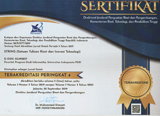Analisis Clustering Virus MERS-CoV Menggunakan Metode Spectral Clustering Dan Algoritma K-Means
(1) Universitas Indraprasta PGRI
(2) Universitas Indraprasta PGRI
(*) Corresponding Author
Abstract
The MERS-Cov virus has spread to other countries outside Saudi Arabia. This is because the MERS-CoV virus can mutate rapidly so it is feared that it could threaten public health and even world health. This virus develops and becomes an acute respiratory disease and the mortality rate reaches 30% among 536 cases. One way to classify the MERS-CoV virus is by grouping the DNA sequences of the MERS-CoV virus which have similar characteristics and functions. Spectral clustering is a grouping method that can identify DNA gene expression. This method is also able to partition DNA data with a more complex structure than the partition clustering method. The purpose of this study was to analyze the MERS-CoV virus clustering using the spectral clustering method and the k-means algorithm. This study used a quantitative descriptive literature approach. The results showed that the results of clustering using the spectral clustering method and the k-means algorithm produced three clusters and were more homogeneous than clustering using k-means only.
Keywords
Full Text:
PDFReferences
N. H. Rampengan, “Middle East Respiratory Syndrome,” J. Biomedik, vol. 8, no. 1, pp. 17–26, 2016.
World Health Organization, “Mers Situation Update November 2019,” 2019.
S. Nur’aini, A. S. Mukaromah, and S. Muhlisoh, “Pengenalan Deoxyribonucleic Acid (DNA) Dengan Marker-Based Augmented Reality,” Walisongo J. Inf. Technol., vol. 1, no. 2, p. 91, 2019, doi: 10.21580/wjit.2019.1.2.4531.
A. Bustamam, E. D. Ulul, H. F. A. Hura, and T. Siswantining, “Implementation of hierarchical clustering using k-mer sparse matrix to analyze MERS-CoV genetic relationship,” AIP Conf. Proc., vol. 1862, no. July, 2017, doi: 10.1063/1.4991246.
S. Ren, S. Zhang, and T. Wu, “An Improved Spectral Clustering Community Detection Algorithm Based on Probability Matrix,” Discret. Dyn. Nat. Soc., vol. 2020, 2020, doi: 10.1155/2020/4540302.
A. Yusuf and H. Tjandrasa, “Prediksi Nilai Dengan Metode Spectral Clustering Dan Clusterwise Regression,” J. Simatec, vol. VIII, no. 1, pp. 39–45, 2013.
A. J. Chin, A. Mirzal, and H. Haron, “Spectral clustering on gene expression profile to identify cancer types or subtypes,” J. Teknol., vol. 76, no. 1, pp. 289–297, 2015, doi: 10.11113/jt.v76.4036.
M. Nafis Ul Alam and U. F. Chowdhury, “Short k-mer abundance profiles yield robust machine learning features and accurate classifiers for RNA viruses,” PLoS One, vol. 15, no. 9 September, pp. 1–23, 2020, doi: 10.1371/journal.pone.0239381.
S. Deorowicz, M. Kokot, S. Grabowski, and A. Debudaj-Grabysz, “KMC 2: Fast and resource-frugal k-mer counting,” Bioinformatics, vol. 31, no. 10, pp. 1569–1576, 2015, doi: 10.1093/bioinformatics/btv022.
D. F. Pramesti, Lahan, M. Tanzil Furqon, and C. Dewi, “Implementasi Metode K-Medoids Clustering Untuk Pengelompokan Data,” J. Pengemb. Teknol. Inf. dan Ilmu Komput., vol. 1, no. 9, pp. 723–732, 2017, doi: 10.1109/EUMC.2008.4751704
DOI: http://dx.doi.org/10.30998/string.v5i3.7942
Refbacks
- There are currently no refbacks.
Copyright (c) 2021 Septian Wulandari

This work is licensed under a Creative Commons Attribution 4.0 International License.
STRING (Satuan Tulisan Riset dan Inovasi Teknologi) indexed by:

Ciptaan disebarluaskan di bawah Lisensi Creative Commons Atribusi 4.0 Internasional.
Statcounter View My Stats


 Sertifikat Akreditasi
Sertifikat Akreditasi
















